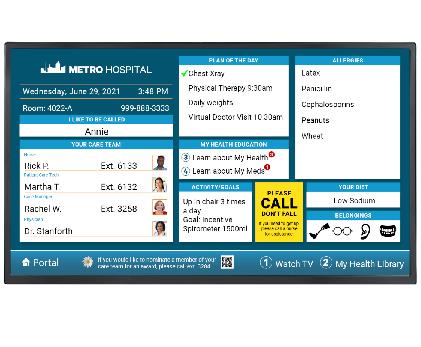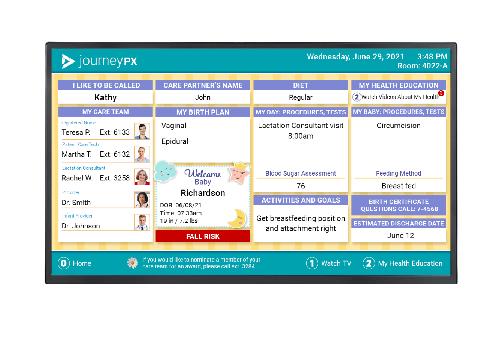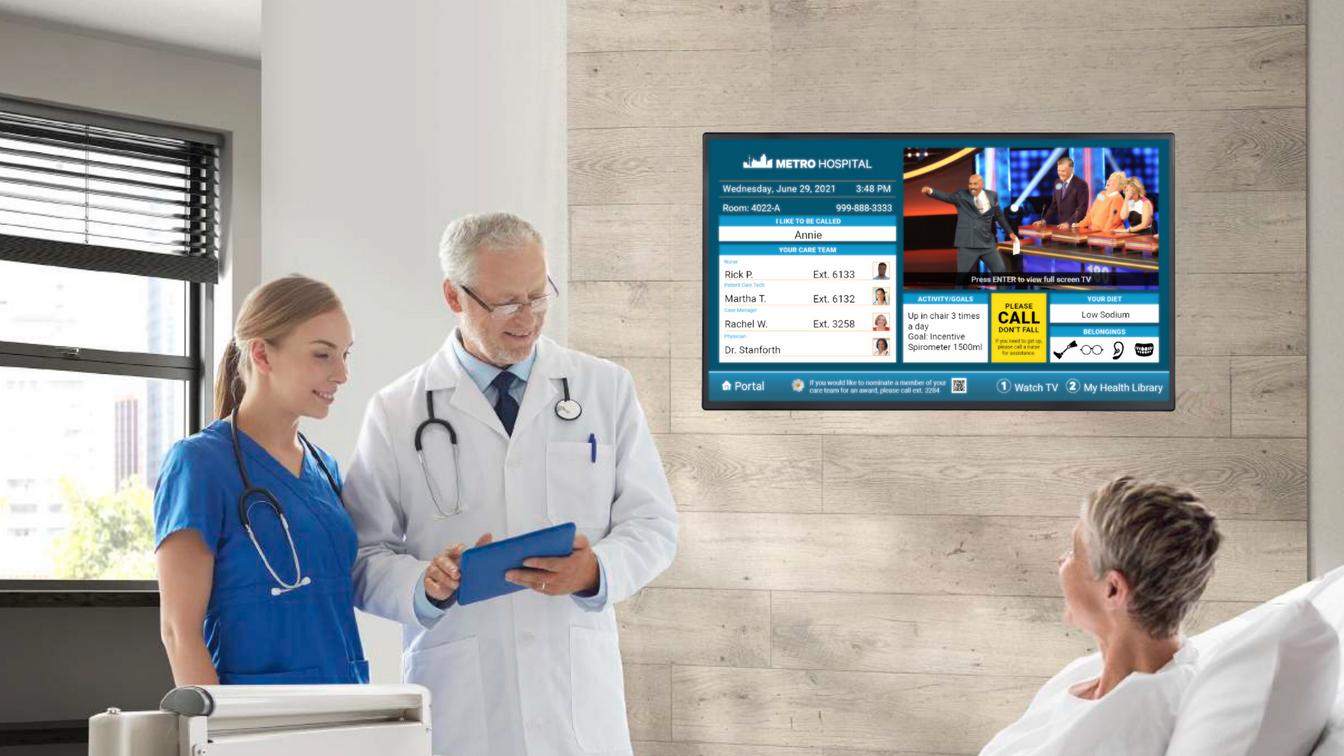
8 minute read
Digital whiteboards Unleashing the Potential of
Linda Robinson, MSN, CPXP, RN Vice President of Clinical Excellence, MDM Healthcare
Effective communication is a crucial aspect of patient engagement and care, enabling shared decisionmaking and a patient- and family-centered approach. The principles at the core of Patient and FamilyCentered Care include respect, dignity, information sharing, participation, and collaboration.1 Therefore, it is essential to treat patients with respect and dignity by providing them with the necessary information to understand their condition in a language they understand and actively participate in their care. Patients’ lives and their involvement are of utmost importance, as they are integral members of the care team. Maintaining open communication throughout a patient’s interaction with the healthcare system ensures their effective participation in care and informed decision-making.
Advertisement
Timely and effective communication is vital for delivering quality patient care, as optimal outcomes are achieved when healthcare providers and patients collaborate based on clinical evidence to make decisions, choose treatments, and develop care plans. Research emphasizes the profound impact of effective communication on patients’ perception of their care and overall hospital experience. Wellinformed patients tend to have better health outcomes and higher satisfaction levels.2 In the realm of nursing, effective communication between nurses and patients plays a critical role in achieving personalized nursing care.1 Patients and caregivers sometimes face conflicting information or lack a comprehensive understanding of their care plan, hindering the shared decision-making process between healthcare providers and patients and their caregivers that support patient-centered care.
Effective communication establishes trust between patients and providers, mitigating negative emotions and facilitating clear understanding of the information being conveyed. While providers may perceive the healthcare system as a high-functioning mechanism, patients often experience fear, anxiety, or confusion at each step. These emotions can impede a patient’s comprehension of critical information related to their medication, treatment, and recovery. Therefore, improving communication plays a vital role in reducing readmission rates, enhancing the patient experience, and fostering a positive culture among healthcare staff. Inadequate communication, on the other hand, leads to higher healthcare costs and negative patient outcomes.11
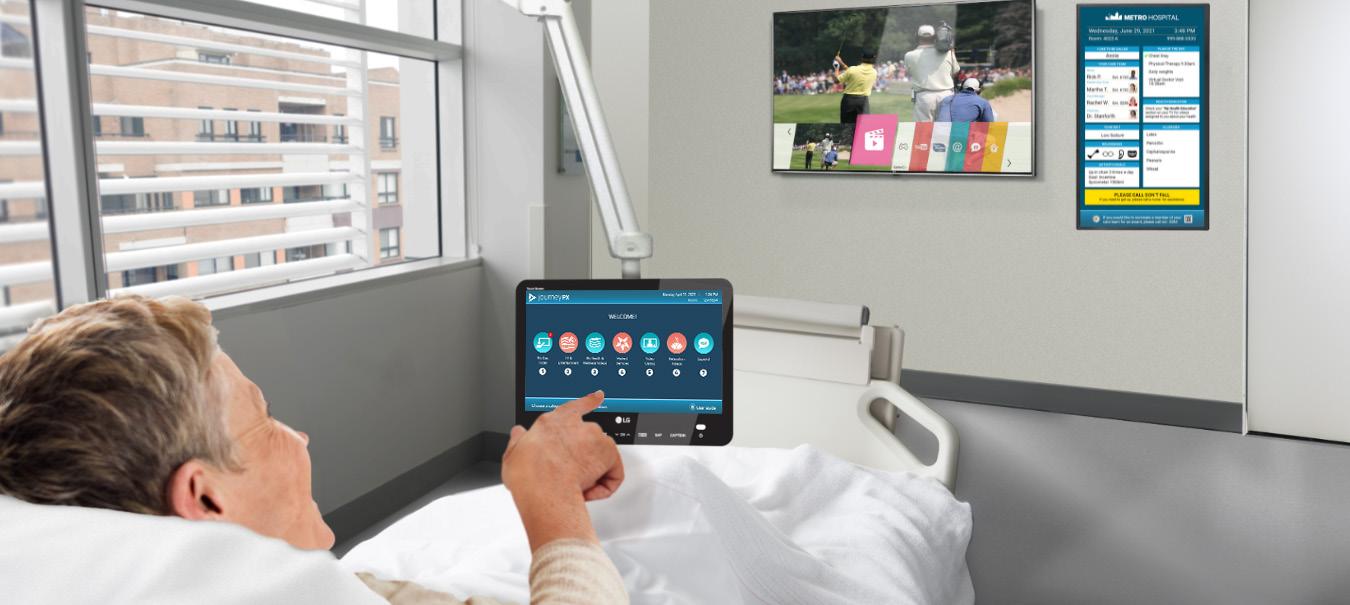
Each communication point between providers and among providers, patients, or family caregivers can potentially contribute to patient safety events. Despite the focus on reducing in-person interactions during the COVID-19 pandemic, it is crucial to recognize and prioritize the ongoing role of communication in delivering safe healthcare. In 2020, researchers explored the challenges of effective communication with patients, the impact of different techniques for improving communication among providers and with patients, and the lessons learned from communication practices during the pandemic, which can be applied beyond the pandemic.2
Looking ahead, it is evident that comprehensive solutions combining both “high-touch” and “high-tech” approaches are necessary to address the complex communication challenges healthcare faces. As healthcare delivery seeks to establish a better “new normal,” further research is required to evaluate communication practices’ feasibility, efficiency, and impact on safety outcomes. While the COVID-19 pandemic caused devastating consequences, the lessons learned about optimal communication during this period offer promise for future improvements. While advances in Health Information Technology are crucial, they should be designed with the understanding that they are not a panacea. In conclusion, well-informed solutions that effectively merge human interaction with technology are needed to tackle the ongoing communication challenges in healthcare.2
Hospitals employ various methods to enhance communication among inpatients, one of which is the utilization of whiteboards. Inpatient whiteboards serve as valuable tools for physicians and ancillary staff, facilitating effective communication and enhancing patients’ awareness of their care team, daily plan of care, risk assessment, activities, goals, education, and duration of stay. These traditional boards are manually updated by nursing staff per shift. However, due to existing workforce shortages, nursing staff may encounter challenges in managing additional responsibilities. Furthermore, limitations in capabilities, accuracy, and adequacy of information have prompted hospitals to explore alternative solutions.5
In an era of rapid digital transformation across industries, healthcare must embrace technological advancements to enhance patient outcomes and streamline operational efficiency.One such innovation gaining momentum is the implementation of digital whiteboards, which serve as modern alternatives to traditional whiteboards or dry erase boards. These digital whiteboards via integrations leverage information and communication technology to revolutionize healthcare processes by delivering accurate, timely, and personalized 24/7 real-time patient information within the confines of the patient’s room, even when healthcare staff are not present. These interactive tools not only replace conventional whiteboards but also offer a multitude of benefits that contribute to improved communication, increased patient engagement, and enhanced overall healthcare quality and safety.3
Multiple studies and research have consistently highlighted the effectiveness and satisfaction associated with digital whiteboards in healthcare settings. A recent study conducted at Brigham and Women’s Hospital found that patients and caregivers who had access to in-room digital whiteboards reported higher satisfaction levels, particularly regarding communication and awareness of delays. They were also more inclined to recommend the facility to their loved ones, with 96% expressing a preference for rooms equipped with digital whiteboards.Furthermore, feedback from participants indicated a strong liking for the whiteboards, with 84% reporting high satisfaction and 92% finding the screen non-distracting. Additionally, 70% of participants acknowledged that the digital whiteboards significantly improved their understanding of their stay.5
In a comprehensive literature review encompassing thirteen studies, digital whiteboards were found to enhance patients’ ability to identify healthcare providers, improve patient-provider communication in four out of five studies, and increase patient satisfaction in eight out of six studies. These findings highlight the advantages of utilizing digital whiteboards in facilitating provider identification, enhancing communication, and elevating patient satisfaction.8
Another study conducted by Stanford University Medical Center compared patients with and without access to digital whiteboards. Patients with whiteboard access demonstrated a higher level of knowledge about their physician’s name, goals of care, and estimated discharge date. Their overall satisfaction with the hospital stay also significantly increased. Physicians, nurses, ancillary staff, and patient families found the whiteboards helpful, leading to their integration into daily workflows. This study concluded that inpatient whiteboards enhance communication among healthcare professionals, improve patients’ awareness of their care team and admission plans, and significantly improve overall patient satisfaction.9
Furthermore, another study revealed that 71% of participants believed that digital whiteboards effectively enhance and standardize communication within the care team. Approximately 62% of participants agreed that the whiteboards save them time when searching for patient information and care plans, promoting efficient communication and streamlined access to essential data.7
Collectively, these studies demonstrate the valuable role of digital whiteboards in healthcare settings, contributing to improved communication, patient satisfaction, and overall efficiency in care delivery.
In the realm of communication, it is also crucial to prioritize patient comprehension. Presenting information in a language that patients can readily understand, while avoiding complex medical terminology, is of utmost importance. Through integration with the electronic medical record, digital whiteboards enable table mapping, thereby facilitating this effective communication approach. This integration ensures that patients and families have equal and equitable access to timely and relevant care information. Moreover, by automatically displaying text in the patient’s preferred language, this inclusive solution ensures that every patient can actively engage in the communication process.
Additionally, embedding this technology into clinically established proven evidence based best practice workflows, such as bedside shift report and rounding practices, enhances patient satisfaction, supports quality assurance, and drives a culture of safety.10 By addressing gaps in patient communication, streamlining care processes, and optimizing nursing operations, digital whiteboards also empower healthcare providers to deliver more efficient, equitable and effective care.
There are multiple reasons why hospitals should invest in digital whiteboards:
Real-Time Communication and Information Sharing
Digital whiteboards play a pivotal role as centralized in-room hubs of information, enabling continuous realtime communication among patients, their families, and the healthcare team. These interactive displays seamlessly integrate with the electronic medical record, offering an intuitive platform for patients, doctors, nurses, and other staff to access patient-related information in a language they understand instantly. In addition, by replacing the manual process of erasing and rewriting on traditional whiteboards, digital whiteboards significantly reduce the risk of errors, misunderstandings, and outdated information, thereby promoting comprehensive and up-to-date communication among all stakeholders.
Enhanced Workflow and Operational Efficiency
Traditional whiteboards are limited in their ability to provide a comprehensive overview of patient status and hospital activities. Digital whiteboards, on the other hand, can integrate with electronic medical record, allowing for seamless data synchronization. This integration enables medical staff and patients to access vital patient information, such as their daily plan of care, individualized relevant health education, and more directly from the whiteboard interface. Consequently, nurses can embed the technology into best practice evidence based clinical workflows leading to improved workflow and operational efficiency.7,3
Improved Care Team Collaboration
Collaboration is the cornerstone of effective healthcare delivery. Digital whiteboards facilitate care team collaboration by offering features such as care team assignments, real-time updates, and instant messaging capabilities. This seamless collaboration reduces communication gaps and enhances interdisciplinary teamwork, resulting in more coordinated and patient-centered care.3,4
Patient Empowerment and Engagement
Patient engagement is vital for better health outcomes. Digital whiteboards provide an interactive medium for patients and their families to participate actively in their care. These boards display personalized information about the patient’s treatment plan, goals, activities, and progress, helping patients understand and actively contribute to their healthcare journey.
Education and Health Literacy
Digital whiteboards can serve as educational tools, helping patients and their families understand complex medical conditions and concepts. With visually appealing interfaces, these boards can display videos, animations, and educational content tailored to the patient’s condition or procedure. This interactive approach enhances health literacy, enabling patients to make informed decisions, actively participate in their care, and effectively manage their health post-discharge.
Data Analytics and Performance Monitoring
Digital whiteboards can generate valuable data that can be leveraged for quality improvement initiatives. By tracking patient outcomes, satisfaction scores, and care team performance metrics, hospitals can identify areas for improvement and implement evidence-based changes. These boards provide a comprehensive view of real-time data, enabling healthcare administrators to make data-driven decisions, allocate resources efficiently, and measure the effectiveness of interventions over time.
In conclusion, investing in digital whiteboards is a significant step towards modernizing healthcare facilities and enhancing patient care. These interactive tools optimize communication, streamline workflow, promote patient engagement, and empower healthcare providers to deliver high-quality, patient-centered care.4 By embracing digital transformation, hospitals can revolutionize their operations, improve health outcomes, and create a more efficient and engaging healthcare environment for both patients and care teams.
Hospitals in the market for this product should consider the LG ML5K Series Patient Engagement Board. Designed specifically for hospitals, this model allows patient engagement providers to combine the security of electronic medical records management with the familiar experience of a personalized information board. This smart signage is UL-listed for hospitals, and the 32″ size can even be powered over ethernet cable (PoE) which can help minimize the impact of installation in existing patient rooms. Key features of the ML5K model includes WebOS, UL Listed for Hospitals, Power over Ethernet (PoE), and Light Sensor with Auto Brightness.
The right software is an essential component of an exemplary digital whiteboard set up inside the patient room. Enrich your patient experience with the right software for your patient engagement board. Consider pairing your patient engagement boards with MDM Healthcare’s innovative Journey PX patient engagement platform. Journey PX is a cutting-edge, cloud-based platform that elevates patient engagement throughout the continuum of care.
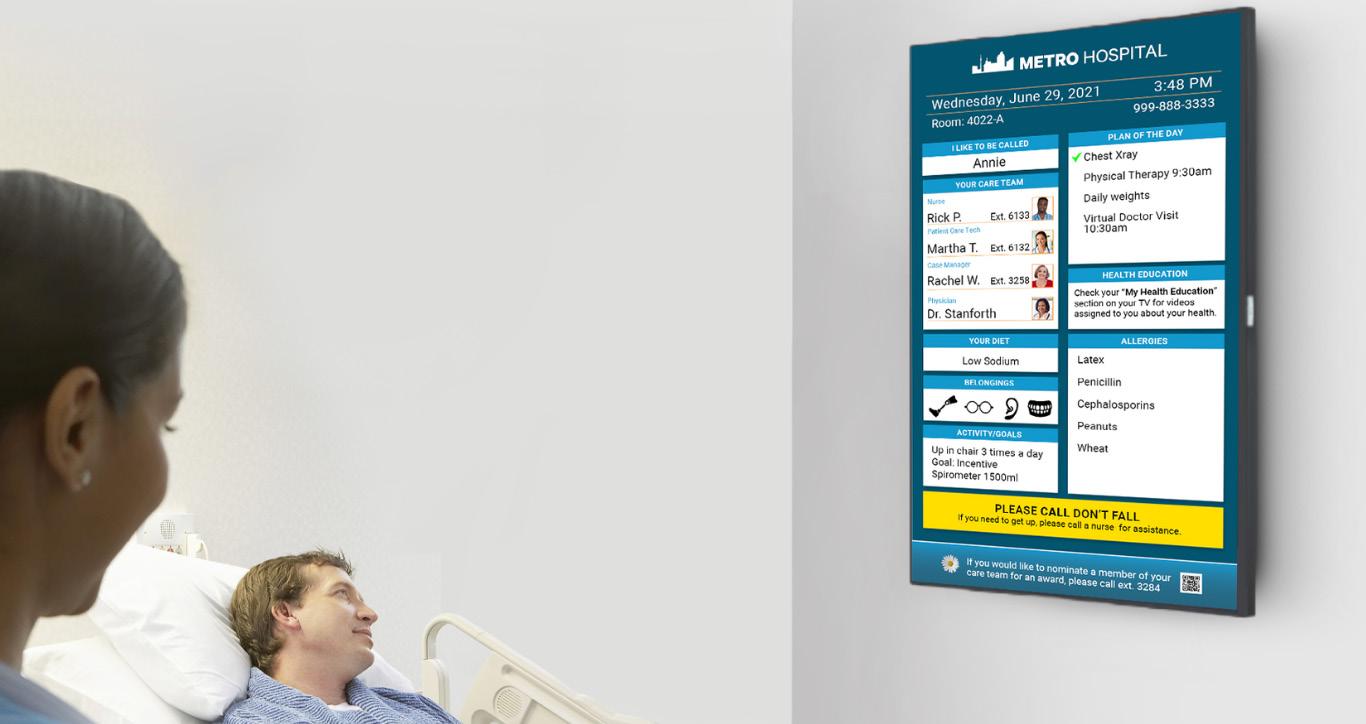
This scalable, cost-effective software will work for any size facility and help streamline care team operations. The Journey PX My Day, Today digital whiteboard will help close the communication gap between care teams and patients. Instead of manually updating a dry-erase board and risking a lack of information transfer between shift changes, important patient care information is always on display. My Day, Today integrates with most EMRs, and offers personalized, vital 24/7 real-time information for the patient and care team. My Day, Today can be activated with RTLS technology, which eliminates manual processes and ensures data accuracy. A key benefit of having My Day, Today inside your patient rooms is to keep patients and families informed of their daily plan of care. This vital daily plan of care information is on display for the patient 24/7 in real-time including patient restrictions/precautions, care team information, schedule, education progress, discharge plan, goals, activities and more! If you are interested in learning more about adding Journey PX to your hospital, contact us for a free demo of Journey PX to bundle with your patient engagement boards.
